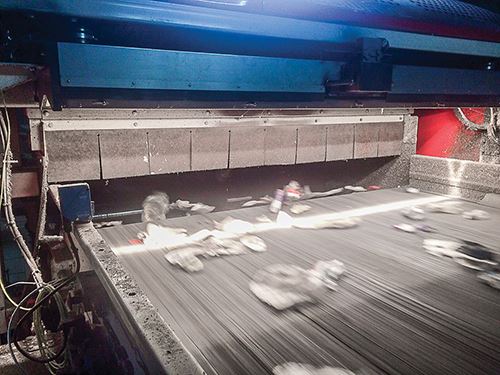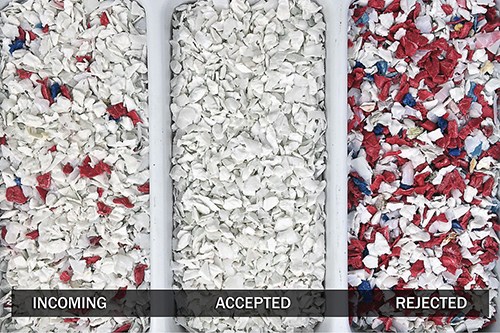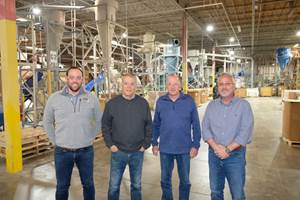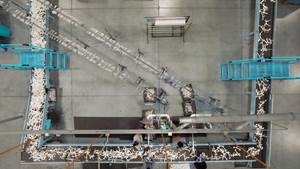RECYCLING: Recycling’s ‘Vision’ of the Future
Optical sorting technology continues to help push advances in plastics recycling.
Plastic recycling has come a long way over the last few decades. Expanded collection efforts, increased demand for reclaimed material, and technology advances have combined to allow greater recovery of materials. While technology innovation spans a wide range of processes—from shredding through compounding and extrusion—one category that is receiving more attention and credit for growing recovery opportunities is automated sorting technology.
Basically, automated sorting technology processes information with a computer and sorts materials with pneumatic air knives. The technology comes in a few varieties, including:
• Vision technology: This is essentially a camera that can sort colors and shapes;
• Infrared technology: This is used to differentiate between resin types by their IR absorption spectra. This category of optical sorters includes near-infrared (NIR), mid-infrared (MIR) and Raman laser spectroscopy;
• X-ray technology (XRF and XRD): This allows users to “see through” the plastics at the elemental level and detect heavy elements such as chlorine and bromine, differentiating PVC from look-alike PET, and detecting brominated flame retardants that cannot be returned to manufacturing in some markets.
These technologies can be capable of sorting large volumes of whole containers, large plastic pieces, or small flakes in mass quantity. NIR and XRF technologies can also be miniaturized into handheld units that allow for individual identification of a piece or part.
As collection programs have moved beyond just PET and HDPE bottles, sorting a more varied mix of plastics is increasingly important to reduce contamination in bales and to enable more commodity plastics to be added to the recycled stream. At materials recovery facilities (MRFs), for example, optical sorting technologies are now being used to recover PP. As plastics-recovery processes have extended beyond the curbside bin, optical sorting has been instrumental in reclaiming plastics from durable goods like electronics and automobiles.
The key limitation to optical sorting in these applications is the inability of infrared sorting technologies to identify and separate plastics that contain carbon black. The presence of that black pigment prevents the transmission of infrared light back to the sensor, so no resin signature is bounced back from the plastic. But this limitation too may be soon overcome. More on that later.
SORTING IT ALL OUT
One of the best attributes of plastics— the ability to customize materials to precisely fit the application—is also one of the things that make them more challenging to reclaim than other materials. This high level of customization results in a broad spectrum of plastics that need to be identified and sorted at end of life. As we move deeper into the end-of-life pile of plastics, optical sorting technologies will continue be the key to driving forward in recycling. There are a number of examples we can explore to see how optical sorting equipment is making more meaningful recovery of plastics possible.
THE RISE OF THE PRF
While most people know of MRFs, a new generation of sorting facilities are popping up across North America called PRFs (Plastics Recovery Facilities). PRFs have become instrumental in creating the domestic reclamation capacity to recover the plastics from Nos. 3-7, or what has become known as “pre-picked bales” that are generated by the typical MRF. At one time these bales were typically shipped to China, but with Green Fence regulations, they are now refused entry at Chinese ports. This has created an opportunity to recover and reuse these materials domestically. But with labor costs being significantly higher in the U.S., effective separation technology must play a role in order to minimize the human element.
This spring, the SPI Rigid Plastic Packaging Group had the opportunity to visit QRS near Atlanta, a PRF that has been instrumental in expanding recovery of non-bottle rigid packaging in the U.S. QRS is at the forefront of industrial-scale optical sorting technology. One of the resins that it has been targeting in recent years is PP, which had not been recovered on a large scale in the U.S. until recently. Dave Bellon, managing partner of QRS Direct (QRS’ sourcing and brokerage arm), notes that the lessons the company learned with PP are now being applied to resins such as rigid PS and PVC.
Because of the massive amounts of plastics QRS handles, even resins that aren’t used a lot in packaging eventually add up to big volumes. Thanks to optical sorting technology, further sorting the mixed pile creates greater value for the material in the end, provided there is a market and demand for it.
While optical sorting has made meaningful recovery of some new plastics possible, Bellon warns that there are a number of factors working against recyclers right now, even ones that employ state-of-the-art processing equipment. Bale quality is one. As the old adage says, “garbage in, garbage out.” Optical sorters can only do a good job if the incoming stream is largely plastics. QRS has to sort out lots of non-plastic items (paper, old shoes, etc.) before the plastics reach the optical sorting system.
Bellon notes, “Optical sorters are not plug- and-play. There’s maintenance of the machine itself and mastering the nuances of the technology, which takes talent and time. There is also the issue of quality of the inbound stream, and you need to understand your suppliers, because everyone’s material is a little different in composition.” While these factors have been a challenge for QRS, the company is slated to open its biggest PRF yet in the Baltimore area later this year
A report released this summer suggest the growing importance of optical sorting technology today in yet another type of reclaim facility: “dirty MRFs.” These facilities receive all discarded materials and require no sorting of recyclables from trash. In The Evolution of Mixed Waste Processing Facilities, a report prepared by Gershman, Brickner & Bratton, Inc. on behalf of the American Chemistry Council, optical sorting was identified as a key technology in helping dirty MRFs make the leap to “mixed-waste processing facilities” that produce high diversion rates and good-quality, marketable recyclable commodities.
SORTING IT ALL OUT
In addition to affording more detailed recovery of plastics at PRFs, the industry is also beginning to explore how products can be better designed to communicate more information to optical sorting systems to optimize recovery. Two examples of this were presented at the SPI Tech Summit held this past February.
The first tackles the challenge of traditional black plastics not being read by infrared technology. Think about the prevalence of plastic items in our lives that are black—PET thermoformed trays, electronic housings, etc. These items are colored with carbon black, so they require alternative, non-optical sortation methods. This adds cost and can affect the economics of recycling and material quality. Ed Kosior, managing director of NexTek Ltd., a U.K.-based consulting company specializing in recycling plastics packaging, presented a trial his company conducted to overcome this challenge.
NexTek created a method by which plastics could be colored black by using a mix of colorants rather than carbon black. Without carbon black, these seemingly “black” plastics perform like other plastics and can be effectively sorted by NIR sorters. Carbon black is inexpensive compared with other colorants, so there would be added costs for making these “black” plastics. But this research proves that companies like NexTek can offer design-for-recycling solutions that help expand current optical sorting capabilities of plastics.
Another example of how industry is working to harness the potential of optical sorting can be found in the REFLEX (Recycling of Flexible Packaging) project underway in the U.K., which was presented by Dow Chemical at the Tech Summit. The project has three stated goals: exploring new innovative packaging designs; developing techniques to make blended polymers from flexible packaging that perform in new uses; and improving identification and sorting of recyclable flexible packaging from the waste stream.
All of these objectives are important, but the last will enable the recovery of packages that have been designed for recycling to be diverted into streams for mechanical recycling. The ability to identify these packages as recyclable likely will be provided via an additive that will be detectable by NIR sorting technologies. There are additives available today, such as opalescent markers, that can be detected by infrared technologies and communicate another level of information to sorters beyond just resin type, such as, “Here’s my unique signature, which means I’m a designed-for-recycling pouch, so send me to that pile for recycling.” Embedded messages of all types could eventually be built into packaging and products, including information about compounded materials, multi-layer products, etc. Unlocking this additional layer of information will only happen through the use of optical sorting technologies.
From these application and research examples, it’s clear that optical sorting holds the key to unlocking major advances in plastics recycling. I once had a recycler tell me that his optical sorter was “the brains of his operation.” While there is no magic bullet for solving all recovery challenges, from a technology perspective optical sorting holds a great deal of potential in driving the recycle value chain forward in the recovery of more plastics in a precise and cost-efficient way.
Related Content
Building a Future With Sustainable Compounds
With roots in recycling, Star Plastics produces engineering thermoplastic compounds to meet performance and environmental goals.
Read MoreEvolving Opportunities for Ambitious Plastics Recycler
St. Joseph Plastics grew from a simple grinding operation and now pursues growing markets in recycled PP, food-grade recycled materials, and customized post-industrial and post-consumer compounds.
Read MoreReversing Logistics for Plastic Film Recycling
Learn how Mainetti built a circular supply chain for clear film packaging.
Read MoreBreaking News From NPE2024
Here is a firsthand report of news in injection molding, extrusion, blow molding and recycling not previously covered.
Read MoreRead Next
See Recyclers Close the Loop on Trade Show Production Scrap at NPE2024
A collaboration between show organizer PLASTICS, recycler CPR and size reduction experts WEIMA and Conair recovered and recycled all production scrap at NPE2024.
Read MoreMaking the Circular Economy a Reality
Driven by brand owner demands and new worldwide legislation, the entire supply chain is working toward the shift to circularity, with some evidence the circular economy has already begun.
Read MoreBeyond Prototypes: 8 Ways the Plastics Industry Is Using 3D Printing
Plastics processors are finding applications for 3D printing around the plant and across the supply chain. Here are 8 examples to look for at NPE2024.
Read More




























